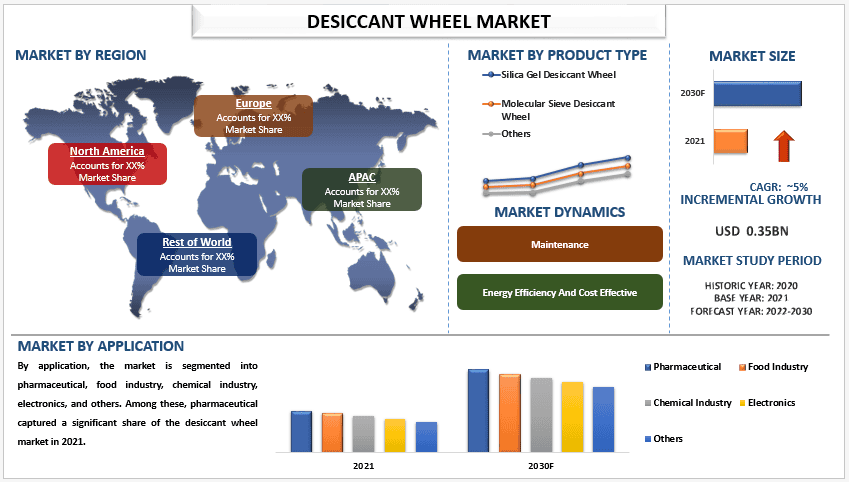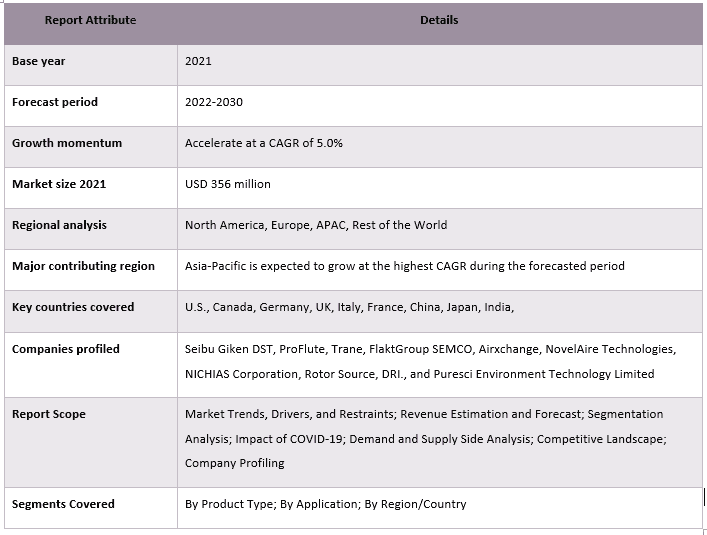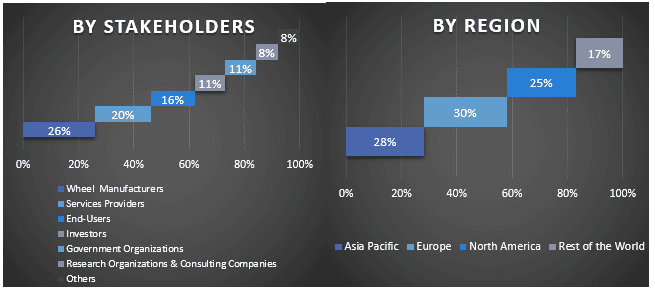Рынок осушающих роторов: текущий анализ и прогноз (2022–2030 гг.)
Акцент на типе продукта (силикагелевое десикантное колесо, молекулярно-ситовое десикантное колесо и другие) и применении (фармацевтика, пищевая промышленность, химическая промышленность, электроника и другие); регион/страна.

Объем рынка осушающих колес в 2021 году оценивался в 356 миллионов долларов США, и ожидается, что в период с 2022 по 2030 год он будет расти со среднегодовым темпом роста в 5,0%. Это обусловлено способностью удалять влагу из воздуха и поддерживать оптимальную производительность. Поскольку спрос на системы кондиционирования и охлаждения продолжает расти, особенно в развивающихся странах, ожидается, что спрос на осушающие колеса также увеличится. Более того, с ростом осведомленности о необходимости и преимуществах технологии осушающих колес, расходы на разработку продуктов и НИОКР во всем мире увеличились. Осушающие колеса обычно используются в системах охлаждения электронных устройств и оборудования. Поскольку спрос на электронику продолжает расти, особенно на развивающихся рынках, ожидается, что спрос на осушающие колеса также увеличится, особенно в развитых и развивающихся странах. Кроме того, правительства различных стран реализуют политику и инициативы, направленные на содействие повышению энергоэффективности и устойчивости. Например, 4 апреля 2023 года осушение моста в Генуе с помощью осушителей DST7 RLZ-82R было успешно установлено на новом мосту Святого Георгия в Генуе, Италия, компанией Seibu Giken DST.
Некоторые из основных игроков, работающих на рынке, включают Seibu Giken DST, ProFlute, Trane, FlaktGroup SEMCO, Airxchange, NovelAire Technologies, NICHIAS Corporation, Rotor Source, DRI. и Puresci Environment Technology Limited. Эти игроки осуществляют несколько слияний и поглощений, а также партнерств, чтобы предоставить клиентам высокотехнологичные и инновационные продукты/технологии.
Основные сведения, представленные в отчете
«Среди типов продукции значительный темп роста демонстрирует сегмент осушающих колес с молекулярным ситом».
На основе типа продукта рынок сегментирован на осушающие колеса с силикагелем, осушающие колеса с молекулярным ситом и другие. Среди них сегмент осушающих колес с молекулярным ситом демонстрирует значительный рост на рынке в 2021 году. Это связано с тем, что осушающие колеса с молекулярным ситом разработаны таким образом, чтобы быть компактными, что упрощает их установку и использование в широком спектре применений. Они могут быть интегрированы в существующие системы и легко транспортироваться, что делает их очень универсальными.
«Среди областей применения значительный темп роста демонстрирует сегмент электроники».
По областям применения рынок сегментирован на фармацевтическую, пищевую, химическую промышленность, электронику и другие. Среди них сегмент электроники демонстрирует значительный рост на рынке осушающих колес в 2021 году. Рост сегмента электроники можно объяснить высокой энергоэффективностью, что делает их привлекательным вариантом для производителей, стремящихся снизить потребление энергии. Кроме того, они разработаны таким образом, чтобы быть компактными и экономичными с точки зрения занимаемого пространства, что делает их идеальными для использования в электронных устройствах и оборудовании, где пространство ограничено.
«Ожидается, что в течение прогнозируемого периода Азиатско-Тихоокеанский регион будет расти самыми высокими темпами CAGR».
Ожидается, что рынок осушающих колес в Азиатско-Тихоокеанском регионе станет свидетелем значительного роста благодаря различным факторам. Индустриализация и урбанизация региона стимулируют потребность в системах кондиционирования и охлаждения, которые используют осушающие колеса для регулирования влажности. Кроме того, в регионе растет спрос на энергоэффективные технологии, что стимулирует внедрение осушающих колес. Эти системы более энергоэффективны, чем традиционные холодильные системы, и могут помочь снизить потребление энергии и затраты. Правительственные инициативы и политика также способствуют росту рынка осушающих колес в Азиатско-Тихоокеанском регионе. Политика, направленная на содействие внедрению энергоэффективных технологий, расширяет рынок. Более того, инвестиции в индустрию HVACR, которая является основным потребителем осушающих колес, стимулируют рост рынка в этом секторе.
Охват отчета о рынке осушающих колес

Причины купить этот отчет:
- Исследование включает анализ размеров рынка и прогнозирование, подтвержденный проверенными ключевыми экспертами отрасли.
- Отчет представляет собой краткий обзор общих показателей отрасли с первого взгляда.
- Отчет охватывает углубленный анализ видных отраслевых аналогов с основным упором на ключевые финансовые показатели бизнеса, портфели продуктов, стратегии расширения и последние разработки.
- Подробное изучение драйверов, ограничений, ключевых тенденций и возможностей, преобладающих в отрасли.
- Исследование всесторонне охватывает рынок по различным сегментам.
- Глубокий анализ отрасли на региональном уровне.
Варианты настройки:
Глобальный рынок осушающих колес может быть дополнительно настроен в соответствии с требованиями или любым другим сегментом рынка. Кроме того, UMI понимает, что у вас могут быть свои собственные потребности в бизнесе, поэтому не стесняйтесь связаться с нами, чтобы получить отчет, который полностью соответствует вашим требованиям.
Содержание
Методология исследования для анализа рынка осушающих роторов (2022–2030 гг.)
Анализ исторического рынка, оценка текущего рынка и прогнозирование будущего рынка глобального рынка осушающих роторов были тремя основными этапами, предпринятыми для создания и анализа внедрения осушающих роторов в основных регионах мира. Было проведено исчерпывающее вторичное исследование для сбора исторических данных о рынке и оценки текущего размера рынка. Во-вторых, для подтверждения этих данных были приняты во внимание многочисленные результаты и предположения. Кроме того, были проведены исчерпывающие первичные интервью с экспертами отрасли по всей цепочке создания стоимости глобального рынка осушающих роторов. После предположения и подтверждения рыночных показателей посредством первичных интервью мы использовали восходящий/нисходящий подход к прогнозированию общего размера рынка. После этого были приняты методы разбивки рынка и триангуляции данных для оценки и анализа размера рынка сегментов и подсегментов, к которым относится отрасль. Подробная методология объясняется ниже:
Анализ исторического размера рынка
Шаг 1: Углубленное изучение вторичных источников:
Было проведено подробное вторичное исследование для получения исторических данных о размере рынка осушающих роторов из внутренних источников компании, таких как годовые отчеты и финансовая отчетность, презентации результатов деятельности, пресс-релизы и т. д., и внешних источников, включая журналы, новости и статьи, правительственные публикации, публикации конкурентов, отраслевые отчеты, сторонние базы данных и другие надежные публикации.
Шаг 2: Сегментация рынка:
После получения исторических данных о размере рынка осушающих роторов мы провели подробный вторичный анализ для сбора исторических данных о рынке и доле различных сегментов и подсегментов для основных регионов. Основные сегменты, включенные в отчет, — это тип продукта и применение. Кроме того, был проведен анализ на уровне стран для оценки общего внедрения моделей тестирования в этом регионе.
Шаг 3: Факторный анализ:
После получения исторических данных о размере рынка различных сегментов и подсегментов мы провели подробный факторный анализ для оценки текущего размера рынка осушающих роторов. Кроме того, мы провели факторный анализ с использованием зависимых и независимых переменных, таких как тип продукта и применение рынка осушающих роторов. Был проведен тщательный анализ сценариев спроса и предложения с учетом основных партнерств, слияний и поглощений, расширения бизнеса и запуска продуктов в секторе рынка осушающих роторов по всему миру.
Оценка текущего размера рынка и прогноз
Определение текущего размера рынка: На основе действенных данных, полученных на основе вышеуказанных 3 шагов, мы определили текущий размер рынка, ключевых игроков на глобальном рынке осушающих роторов и доли рынка сегментов. Все необходимые процентные доли и разбивки рынка были определены с использованием вышеупомянутого вторичного подхода и проверены посредством первичных интервью.
Оценка и прогнозирование: Для оценки и прогнозирования рынка различным факторам были присвоены веса, включая драйверы и тенденции, ограничения и возможности, доступные для заинтересованных сторон. После анализа этих факторов были применены соответствующие методы прогнозирования, т. е. восходящий/нисходящий подход, для получения прогноза рынка на 2028 год для различных сегментов и подсегментов на основных рынках мира. Методология исследования, принятая для оценки размера рынка, включает:
- Размер рынка отрасли с точки зрения выручки (доллары США) и темпы внедрения рынка осушающих роторов на основных рынках внутри страны
- Все процентные доли, разбивки и разбивки сегментов и подсегментов рынка
- Ключевые игроки на глобальном рынке осушающих роторов с точки зрения предлагаемых продуктов. Кроме того, стратегии роста, принятые этими игроками для конкуренции на быстрорастущем рынке.
Подтверждение размера и доли рынка
Первичное исследование: Были проведены углубленные интервью с ключевыми лидерами мнений (KOL), включая руководителей высшего звена (CXO/вице-президенты, руководители отдела продаж, руководители отдела маркетинга, руководители операционного отдела, региональные руководители, руководители стран и т. д.) в основных регионах. Затем были обобщены результаты первичного исследования и проведен статистический анализ для доказательства заявленной гипотезы. Вклад от первичного исследования был объединен с результатами вторичного исследования, превратив тем самым информацию в действенные идеи.
Разделение основных участников по разным регионам

Инжиниринг рынка
Метод триангуляции данных был использован для завершения общей оценки рынка и получения точных статистических данных для каждого сегмента и подсегмента глобального рынка осушающих роторов. Данные были разделены на несколько сегментов и подсегментов после изучения различных параметров и тенденций в областях продукта, технологии и конечных пользователей на глобальном рынке осушающих роторов.
Основная цель исследования глобального рынка осушающих роторов
В исследовании были точно определены текущие и будущие рыночные тенденции глобального рынка осушающих роторов. Инвесторы могут получить стратегическое представление, чтобы основывать свои решения для инвестиций на качественном и количественном анализе, выполненном в исследовании. Текущие и будущие рыночные тенденции определили общую привлекательность рынка на региональном уровне, предоставив промышленному участнику платформу для использования неиспользованного рынка, чтобы получить выгоду от преимущества первопроходца. Другие количественные цели исследований включают:
- Анализ текущего и прогнозируемого размера рынка осушающих роторов в стоимостном выражении (доллары США). Также анализ текущего и прогнозируемого размера рынка различных сегментов и подсегментов.
- Сегменты в исследовании включают области типа продукта и применения.
- Определение и анализ нормативно-правовой базы для осушающего ротора
- Анализ цепочки создания стоимости, связанной с присутствием различных посредников, а также анализ поведения клиентов и конкурентов в отрасли.
- Анализ текущего и прогнозируемого размера рынка осушающих роторов для основных регионов.
- Основные страны регионов, изученные в отчете, включают Азиатско-Тихоокеанский регион, Европу, Северную Америку и остальной мир.
- Профили компаний на рынке осушающих роторов и стратегии роста, принятые участниками рынка для поддержания устойчивости на быстрорастущем рынке.
- Углубленный анализ отрасли на региональном уровне
Связанные Отчеты
Клиенты, купившие этот товар, также купили










